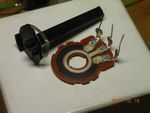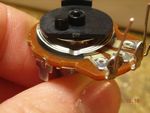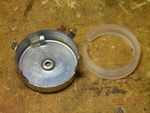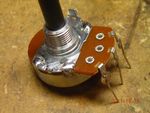

| ▲ Electronics |
I was using a 470kΩ carbon-track pot in part of the feedback network for a little adjustable high voltage supply. The intended adjustment range of the supply was from about 50V up to 400V. It was smooth over most of its range, but I noticed a sudden jump between 370V and 400V, which was unacceptable. I could have gone and bought a better-quality pot, but I'm a curious sort of person, so I ripped the pot apart to see if I could modify it to alleviate the problem!
Take a close look at the second picture below, which shows a closeup of the carbon track and silver end contacts. Note how the carbon track overlaps the silver end contact slightly. Presumably the silver contact was deposited on the board first, then the carbon track was printed/painted on top of it to make a connection. As the wiper is moved towards the end of the track, it goes from being over the carbon track itself, to being over the carbon track on top of the silver contact, to finally being on top of the silver contact directly. As you might imagine, this will cause a small glitch in the resistance at the end of the travel. The variation in resistance will be linear so long as the wiper is over the carbon track itself. When it moves over the carbon track + silver end contact region, the resistance will suddenly drop to a low, but non-zero value, determined by the resistance through the thickness of the carbon track on top of the silver end contact. Finally, when the wiper is over the silver contact directly, the resistance drops to zero, or as near as makes no difference.
There is an added complication - note that there are three "fingers" on the wiper arm, whose tips lie in a radial line from the center. However, the dividing boundary line between the carbon track and the region where it overlaps the silver end contact is not a radial line, meaning that (in this case) the outermost finger passes over the boundary first, followed by the middle and inner fingers. This will actually result in three successive drops in resistance, to lower and lower values each time.
The solution, I found, was to reduce the travel of the wiper so that the new "end" of the track resulted in the wiper stopping over the carbon track, and not going anywhere near the silver end contact (in a position roughly like the one in the fourth photo below). In my 470kΩ resistor, this resulted in about 11kΩ when the wiper was at the "end" position. I realise this might not be a desirable characteristic in all situations, but I was able to adjust the other resistances in my power supply feedback network to again achieve a 50-400V adjustment range. The adjustment is now smooth between 370-400V!
Limiting the travel was achieved simply by glueing a small piece of plastic (cut from a turned piece) to the inside of the housing, so the protrusion on the wiper arm strikes it. The case was reassembled by soldering the four tabs on the rear steel cover to the front cover - I could've bent them back over, but solder is more secure and makes it easier to dismantle it again in future.
 Wiper arm and track PCB |
 Closeup showing track and end contacts |
 Wiper arm fingers |
 Desired "end" position of wiper arm |
 Plastic stop added |
 Case reassembled by soldering tabs |
| ▲ Electronics |